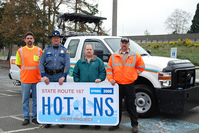Economy, opposition make VDOT postpone I-95/395 HOT lanes
The Virginia DOT has decided to pause its plans to build High-Occupancy Toll (HOT) lanes along I-95 and I-395 from the Pentagon to Spotsylvania County. VDOT hasn’t recognized the folly of its widening plans, but is bowing — at least temporarily — to financial and opposition pressure.
The opposition pressure comes mostly from Arlington County, which is planning a lawsuit against the Federal Highway Administration for the project. Alexandria is considering joining as well.
During the Bush Administration, FHWA gave the project a Categorical Exclusion which essentially says that the project will have no significant environmental effect at all. VDOT did the same for the I-66 widening, and that project wouldn’t have created full through lanes, as the HOT lane project would.
Federal law is clear that “growth inducing effects and other effects related to induced changes in the pattern of land use, population density or growth rate,” also known as induced demand, is indeed an environmental effect.
Arlington is most concerned with the project’s effect on neighborhoods in and around Shirlington, where VDOT proposes changes to Shirlington Circle including more lanes and traffic lights. Residents of nearby neighborhoods worry that the project will add cut-through traffic and that construction will damage historic buildings. The Alexandria Gazette Packet writes,
The Virginia Department of Transportation says that it followed the approved rules to create a document known as an “interchange justification report” that led to federal approval the categorical exclusion. But officials in Alexandria and Arlington believe that the project did not receive an adequate review because roads near the interchanges were not studied.
“Where do you stop?” asked VDOT project manager Young Ho Chang. “The theory is that if the interchange functions better with the project then all the intersections around the interchange will also function better.”
Like his previous statements, Chang seems blind to any possible downside of adding car lanes. This quote reveals the deeply entrenched traffic engineer mindset that “moving cars faster” equals an intersection “functioning better.”
As the West Palm Beach, Florida Neutral Language Policy explains, that’s false. Adding vehicular capacity may make the intersection better for some, but also may worsen it others. For example, widening a typical suburban intersection by adding turn lanes often creates a much more dangerous intersection for pedestrians. That’s why West Palm Beach banned traffic lingo like calling an intersection widening an “upgrade.”
Given that this project will inevitably spur more housing growth in Spotsylvania County for people commuting to DC, generating new traffic, the intersections may become more clogged with cars even with more lanes. Finally, even by traffic engineer standards Chang’s statement makes no sense. If one intersection moves more cars at higher speed, nearby intersections may become more congested. Chang’s statement belies a fundamental belief that any increase in vehicular capacity is an unmitigated good. He seems genuinely baffled as to why Arlington and Alexandria might not want all this goodness he’s trying to bestow on them.
The HOT lane projects are also losing popularity and political support as more residents become aware of the onerous provisions in the Beltway contract, like the requirement that Virginia pay Fluor-Transurban if more than 24% of drivers carpool. Residents along the Beltway have also been surprised at the numbers of trees cut down and the extent of the construction impacts. Most of all, VDOT’s rapidly shrinking budget and a tough credit market have shattered hopes of borrowing from the future to build the freeways today, as Maryland did with the ICC.
Homer insists his staff will continue working hard to sell the plan. We haven’t heard the last of HOT lanes in Virginia.

